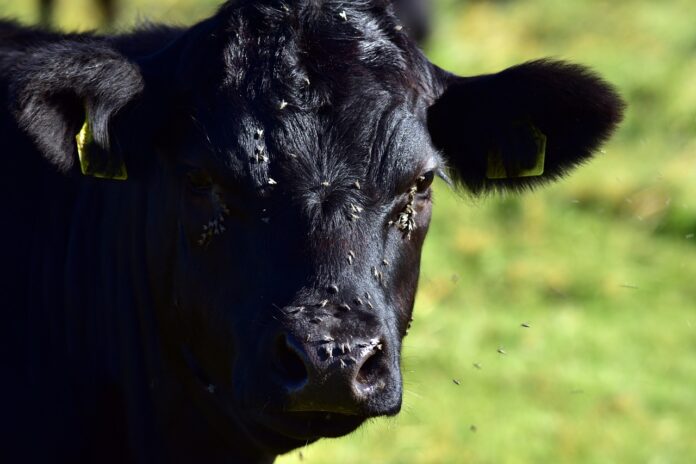Warm weather has arrived for the summer and so have flying biting insects. I have seen estimates that flies cost U.S. livestock producers $700,000 to $1 million dollars annually. With high livestock prices it is more important than ever to keep animal performance at an optimum.
Flies can impact livestock performance by reducing weight gains, milk production and poor feed utilization. The major flies of concern are Horn flies, Face flies and Stable flies. Other annoying pests would include horse flies, deer flies, ticks and mosquitoes.
Types of flies
Horn flies are blood sucking found on the backs of livestock feeding 20 to 40 times per day. Recommended economic levels are reached when populations exceed 200 flies per animal and often peak this time of year. The female adults only leave the hosts to lay eggs in fresh manure. The complete egg to adult life cycle can be completed in 10 to 20 days depending upon the weather.
Stable flies are also serious insects affecting livestock since they too are blood sucking. These are normally found feeding on the legs and belly regions of livestock and can also cause significant reductions in performance. When these flies bite which are often painful, and livestock react to them by stomping their feet or gathering in groups or standing in streams and ponds. Because of the location of feeding areas on the animal these flies can be the most challenging to control. The adult female prefers to lay eggs in wet moist hay or straw mixed with manure such as in feedlots or winter hay feeding areas.
Face flies are not biting insects but rather feed upon livestock secretions from the eye, mouth and nose. This feeding can cause damage to eye tissue which increases the potential for infection and diseases such as pink eye. The females do lay their eggs in fresh manure piles found in pastures.
How to control
Several strategies can be used to help control fly populations. Sanitation is one of the most important management strategies especially in and around feedlots and buildings. As long as breeding locations are available other control efforts will be minimized. Larvicides are an option for pasture and feedlot situations either by applying directly to the fly breeding locations one could also use these products as a feed additive or incorporate into a mineral mixture.
For grazing livestock the first step is to correctly identify which type of fly you have. After correct identification then an application of insecticides directly to livestock can be accomplished using several application methods and products. Options include fly tags, direct spray, misters, pour-on, self-application devices (dust bags or oilers), walk through traps and the newer gun devices that shoots an insecticide capsule and explodes upon contact.
One key factor when using the self-applied applicators is getting your livestock to use them consistently. Often time producers will locate the devices in locations that force the livestock to move through them such as to get to water or mineral. Regardless of the method you use always read the insecticide labels for limitations and withdraw times.
Finally be sure to utilize an integrated fly control program, to reduce resistance issues. Insecticide resistance can develop if less than recommended levels of an insecticide is used, or by using the same insecticide or family of insecticides every year.













